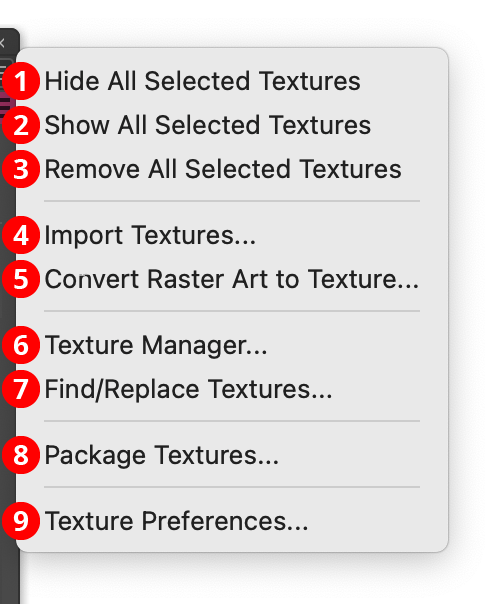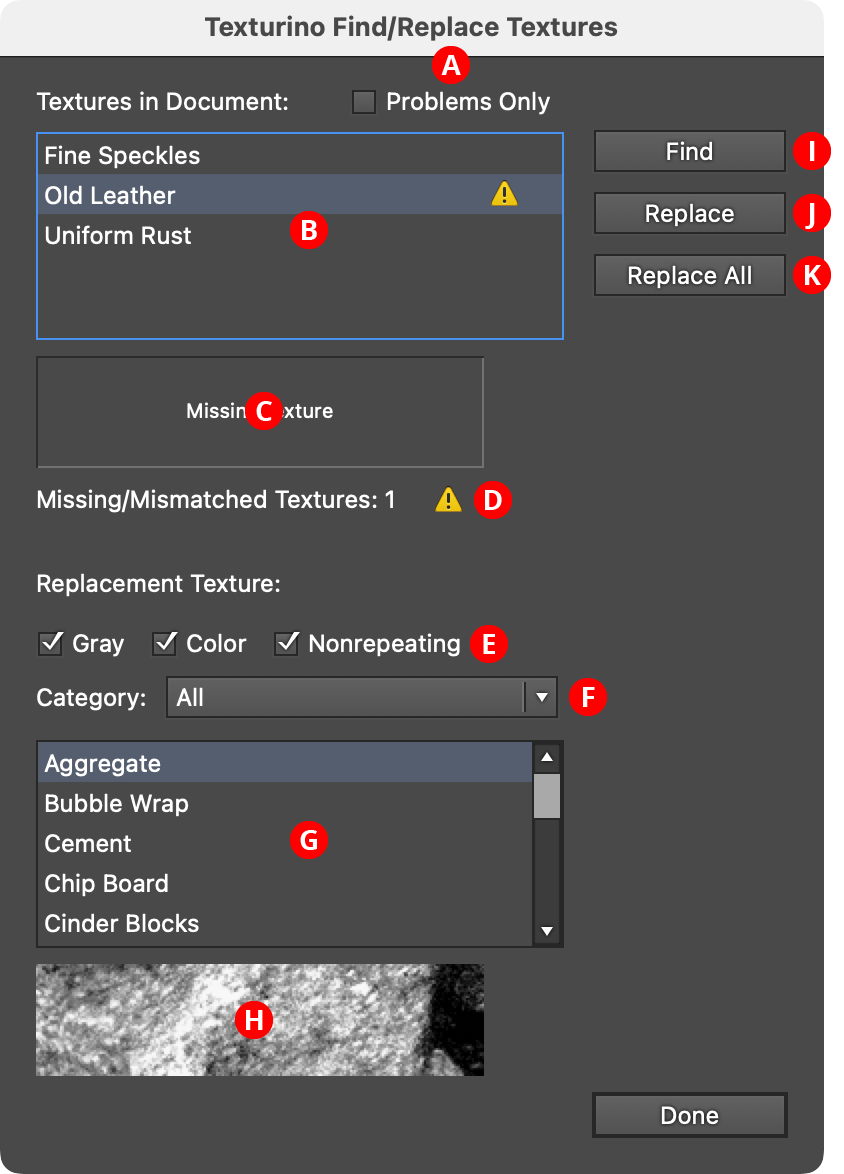 Texture Panel Flyout Menu
Texture Panel Flyout Menu

Texture Panel Flyout Menu
The Texture panel flyout menu items are contextually sensitive and all items may not be available, depending on the current selection.
1. Hide All Selected Textures
For all selected art with one or more non-hidden Texture live effects, causes their textures to be hidden, just as if their Visibility icon were clicked in the native Appearance panel.
2. Show All Selected Textures
For all selected art with one or more hidden Texture live effects, causes their textures to be shown, just as if their Visibility icon were clicked in the native Appearance panel.
3. Remove All Selected Textures
Removes all Texture live effects from all selected art objects.
4. Import Textures...
Imports new textures, as if the Import button on the panel were clicked (see Texture Panel: Import Button).
5. Convert Raster Art to Texture...
Available when one or more raster (embedded) art objects are selected, this function creates a new texture from each raster object, which remains unchanged. After conversion, the Texture Manager will automatically be opened with the newly-converted textures selected. They will have been given names like “Converted,” “Converted [1],” etc., but can be renamed.
6. Texture Manager...
Opens the Texture Manager (see Texture: Texture Manager).
7. Find/Replace Textures...
Opens the Find/Replace Textures dialog, used to locate textures, replace one texture with another, or replace textures which are missing or mismatched:

Find/Replace Textures Dialog
A. Problems Only Checkbox: When enabled, only those textures in the document which are missing (the texture cannot be located) or mismatched (a texture with the same name exists, but it is not the same texture that was originally added) are shown in the top list.
B. Textures in Document List: Lists either all the textures used in the current document, or, if Problems Only is enabled, the missing or misplaced textures in the current document. Problem textures display a warning symbol to the right of their name. When a texture is selected in the list, the document is automatically scrolled so that the first instance of the texture is centered within the document window.
C. Document Texture Preview Area: Previews the selected document texture, unless it is missing or misplaced. A clickable preview size icon will appear when hovering the cursor over the window.
D. Missing/Mismatched Status Line: Shows the number of problem textures in the current document, if any.
E. Filtering Parameters: Act the same as the filtering parameters checkboxes on the panel.
F. Category Popup Menu: Acts the same as the category popup menu on the panel.
G. Texture List: Lists textures that may be used for replacement (textures that match the filter parameters and category specified above).
H. Replacement Texture Preview Area: Previews the selected replacement texture. A clickable Preview Size icon will appear when hovering the cursor over the window.
I. Find Button: Each time the Find button is clicked, the artwork containing the next instance of the selected document texture is selected, and the document is scrolled so that artwork is centered within the document window.
J. Replace Button: Replaces the single instance of the texture that was originally selected or subsequently located using the Find button with the replacement texture, keeping all of its live effect parameters unchanged. Afterwards, the document is automatically scrolled to the next instance of the texture, if any.
K. Replace All Button: Replaces all instances of the selected texture in the document with the replacement texture, keeping all of their live effect parameters unchanged.
All texture replacements made while the Find/Replace Textures dialog is open can be undone in a single operation after the dialog is closed. If the Find/Replace Textures... menu item is unavailable, then there are no textures in the document.
8. Package Textures...
Brings up a dialog that allows you to export all of the textures used in the current document (except missing or mismatched textures) into a folder, the name and location of which can be specified. The textures are exported in PNG format. This is useful when giving the document to another user who also has the Texturino plugin installed and needs to edit the artwork that has Texture live effects. Before opening the document, that user should import all of the textures in the packaged folder so they will be present in their library.

Package Textures Dialog
8. Texture Preferences...
Brings up the Preferences dialog (see Texture: Preferences).
